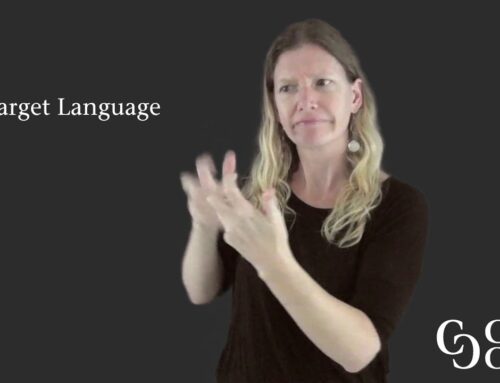 In this video, Julio shares his experience of immigrating to the United States from Guatemala and going through the process of getting his green card and then becoming a citizen.
In this video, Julio shares his experience of immigrating to the United States from Guatemala and going through the process of getting his green card and then becoming a citizen.
Objectives:
- to identify the main ideas in an ASL text;
- to create an accurate English translation of an ASL text.
Time:
This activity will take approximately 30 minutes to complete.
Directions for Practice:
You will do the following steps for this activity:
- Predict
- Watch the video
- Create a written translation of text
- Check your work
Prediction:
Spend a minute thinking about what Julio might talk about in his story of immigrating to the United States from Guatemala and becoming a U.S. citizen. What are the steps in that process? What might be some of the language features you think he will use?
This time is an important way to use the priming effect to prepare your brain for more durable learning.
Watch the Video
The video is 3:04 in length. You may want to take notes as you watch to assist you in your translation work.
Create a Written Translation of the ASL Text
Write an English translation of the ASL text.
Feature Alert:
There are many examples of depiction in the ASL text, as well as some scenarios that do not have specificity about location, but depend on an understanding of the Immigration and Naturalization process. As best as you are able, try to craft the translation using whatever background knowledge you have of the process of becoming a citizen – at least as it was 2003 when the events in this story took place.
Checking Your Work
Use the following translation as a comparison for your own work. Note that it is not the way to translate it, only one option. It also has not been checked with the original storyteller, so may contain inaccuracies in the work. Also, pay attention to the translator’s notes at the bottom about the choices made in the translation process and the questions that remain.
Becoming a Citizen
Translation by Doug Bowen-Bailey
In 2003, I became a citizen. Before that happened, there was quite a process. I went through a divorce and ended up going back to Guatemala. There was a new president elected, and so I began the process of applying to immigrate to the United States.
I had to undergo a series of questions to determine if I was eligible for immigration. One of the questions was if I had ever been to jail. I didn’t hold back that I had indeed been in jail for fighting. The official followed up by asking me if I had ever stolen anything to which I fortunately was able to reply that I hadn’t. I learned then that having been jailed for stealing something would have meant that my application would have been denied.
I had to wait while they processed my application. After a few hours, I learned through an interpreter present that they had granted my request and I was cleared to go to the United States. They gave me all the proper documentation that I needed and I was so relieved to be through this step.
Later, I flew to the United States with all of the documents I needed. Upon arrival, I explained to an official that I was Deaf and had my documents with me. I was ushered to a place where I waited as the official went through all of my paperwork. Eventually, my papers were stamped with all the official seals and I was sent on my way into the U.S. That news really helped settle my nerves.
Just three months later, I received my government-issued ID card*. It came more quickly than I expected and I was able to go out and find a job. It wasn’t too long before I got the advice that I should pursue becoming naturalized as a citizen. I gave it some consideration but decided to go for it.
I got to work on studying for the exam I knew I would have to take. There were 100 questions that I was working on memorizing. It was really challenging. As the time approached for the text, someone quizzed me on all the questions. I did pretty well for 50 questions, though I forgot a few of them.
I was nervous the next day thinking about how challenging it would be to remember all of the answers for the 100 questions I had studied. I went in a tie – trying to look my best. The man who was administering the test was also in a tie, but his expression made him seem gruff. I introduced myself through an interpreter and then received instructions for how the test would go.
As it started, I didn’t remember everything, but it seems like it came out well through the interpretation. We went through about 5 questions when the examiner told me I had passed, and gave me an American flag to celebrate. I have to admit to a little disappointment that I had spent all that time studying 100 questions when I only had to answer so few.
I was, however, really happy to have made it through the process and become a citizen. It was quite a journey for me.
Notes on the Translation
I created this interpretation as an opportunity to practice the process. My goal was to try to narrate my way through the depictions – avoiding “he said” or “she said.” One interesting challenge I found was that in the ASL pronominalization, it is easy to tell the story without any reference to gender. To manage that, I avoided using “he” or “she” and instead used “the official” or “the examiner” – and also used passive voice to maintain the ambiguity.
*I also chose to keep ambiguity with the card that he received 3 months after arriving in the U.S. In my mind, it was either a Social Security Card or a Green Card documenting Permanent Resident status. Rather than attempt to guess, I decided to go with “government-issued ID card”.
Re-Watch the Video
To enhance the durability of your learning, wait one day or more to watch the video. Before watching it, try to re-call as much as you can about the original video (and your translation) without looking at the written translations. You may even want to do a content mapping exercise to strengthen this retrieval activity.
Then, watch the video again and compare your comprehension the second time with your original comprehension.




